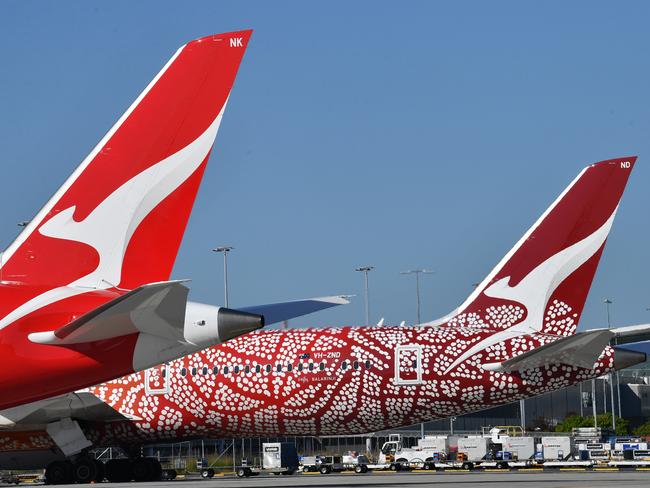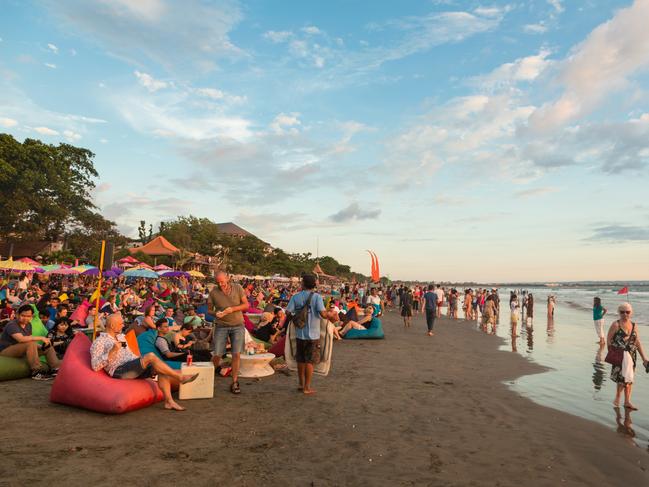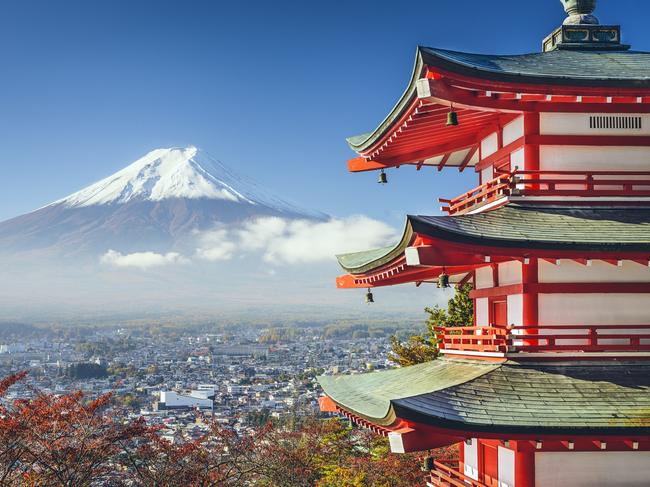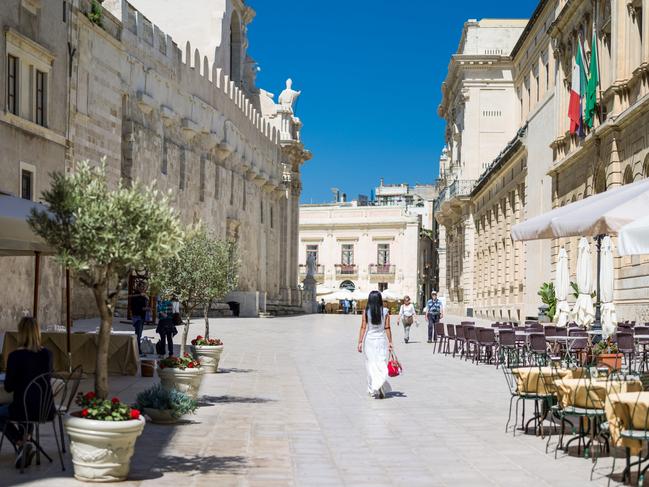Qantas, Jestar to ramp up flights as international travel ban extended
Qantas and Jetstar are set to scale up their domestic services as states move to reopen their borders, but Australians hoping to take off overseas will have to wait a while longer.
Companies
Don't miss out on the headlines from Companies. Followed categories will be added to My News.
Qantas is set to increase its domestic services to 850 return flights a week, but those hoping for an international vacation will have to wait a while longer.
Australia’s largest airline said domestic services would ramp up by the end of July after the states indicated they were interested in restarting domestic travel, The Australian reports.
Qantas CEO Alan Joyce said he wanted to get aircraft back in the air and employees working.
“Unfortunately we had to stand down most of our staff, over 25,000 people; we had to ground 220 aircraft,” he said. “We were hibernating the airline (but) the airline is still there, it’s keen to go.”
Following a National Cabinet meeting yesterday, most states said their borders would re-open in July as part of Australia’s fast-tracked third stage of lifting coronavirus restrictions.
Queensland has set a July 10 target to reopen borders, while SA is expected to let interstate travel restart on July 20.
WA and Tasmania are yet to confirm if they will meet National Cabinet’s guidelines of July border openings.

The 850 flights would be across both Qantas and Jestar, up from 350 a week by the end of June, boosting frequencies and the number of destinations to which the airlines operated, according to The Australian.
Virgin Australia is also reportedly in the process of increasing flights to 160 return services a week, from 76 presently.
But as domestic travel begins to return to normal, Australia’s international travel ban has been extended.
The ban on international departures was due to expire on June 17, but it will now carry on until September 17.
However, a Health Department spokesman told The Australian it would not stop authorities from exploring travel “bubbles” with New Zealand or other nations that had made good progress in suppressing COVID-19 transmission rates.
“The human biosecurity emergency is currently in force until September 17, 2020 — it was extended on May 15, 2020, for a further three months to ensure the Australian government continues to have an appropriate range of powers available to manage the ongoing pandemic response,” the spokesman told The Australian.
“The outgoing travel restriction on Australian citizens and permanent residents is currently in effect for the duration of the emergency period.
“Amending these restrictions, for example to enable travel to NZ, is a decision for both governments that will be made in due course, when the public health risk is assessed as being sufficiently safe. The Australian and New Zealand governments continue to work together on this matter.”
NZ WANTS EARLY ENTRY TO TRAVEL BUBBLE
Australian states and territories who have adequately dealt with COVID-19 should be given early access to the trans-Tasman travel bubble, according to Deputy New Zealand Prime Minister Winston Peters.
Mr Peters said states such as Tasmania shouldn’t be held back as they emerge from lockdown by “slower movers”. He then identified Victoria as “a bit of a worry”.
“I’m certain when we’ve got all the protocols sorted out, which can be done very, very quickly, because so much work has been done, we can be off,” Mr Peters told Channel 7’s Sunrise.
“Let’s not restrain the movement between our two countries based on the slowest state in Australia.”
Mr Peters said a review or “post-mortem” would be undertaken on the speed and spread of New Zealand’s shutdown. He also noted the performance of Australia’s states and territories in balancing the economic and health risks.
“The performance of Queensland, Northern Territory and, dare I say it, Tasmania, has been superior to New Zealand’s in many ways even though we’ve done surprisingly good,” he said.

New Zealand health experts are confident the travel bubble plan could start as soon as next month, as the country appears to have completely eradicated the coronavirus, at least for now.
The move to international travel via the states would allow the $3 billion trans-Tasman trade to be fired up again. Last year around 1.5 million Australians holidayed in New Zealand, making up 40 per cent of foreign visitors to the Shaky Isles.
New Zealanders make up the second biggest source of visitors in Australia behind China. Around 1.4 million New Zealanders came to Australia last year, comprising 15 per cent of total visitor numbers.
However New Zealand Prime Minister Jacinda Ardern has this week been cautious about the rollout of such a plan. In Australia, the National Cabinet is looking at a September start as the most likely time frame. But the distinct possibility remains that Australians in states and territories, such as Tasmania and the Northern Territory, that have moved further along the path of easing health restrictions may be able to travel overseas before they can travel interstate.
It has been 19 days since New Zealand recorded their last COVID-19 infection.
“We need to make sure they’re (Australia) in a similar position to us in terms of how they’re tracking for cases,” Ms Ardern said.

“We have to make sure that we feel that we’re not losing any of our gains by making the decisions that we’re making – different (Australian) states are in different positions at the moment.
“We’re working on a framework that would help us not just with Australia, because we might need to make these decisions with other countries in the future.”
Coronavirus-free nations such as the Cook Islands, Niue and Taiwan could be part of the travel bubble when it begins. Other nations as far afield as Israel and Norway are also being considered due to the way they have successfully dealt with the virus.
However Federal Health Minister Greg Hunt won’t be pressured into an early decision.
“I won’t put a time frame on it. We’re working closely with New Zealand and we’ll continue to work closely with New Zealand,” he said.
“We’ve both been successful and saved lives and protected lives and when the time is right, then we may well be able to have travel between the states in Australia and between Australia and New Zealand,” he said.
QANTAS, JETSTAR PLAN TO RAMP UP FLIGHTS
Qantas has announced the airline and its low-cost carrier Jetstar will scale up flights on domestic and regional routes in June and July.
It says capacity will increase to 15 per cent of pre-coronavirus levels, or more than 300 more return flights a week, by the end of June.
Australia’s flag carrier is currently operating domestic capacity at just 5.0 per cent of pre-coronavirus levels following government restrictions on travel and stood down two-thirds of its 30,000-member workforce until the end of June.

Qantas said capacity could be increased up to 40 per cent of the group’s pre- crisis domestic capacity by the end of July, depending on demand and further relaxation of state borders.
The airline will boost services on capital city routes, particularly Melbourne- Sydney and a number of routes to and from Canberra.
It will also increase intra-state flights for Western Australia, Queensland, NSW and South Australia.
Qantas said it would also begin flights from Sydney to Byron Bay after the route launch was postponed due to the coronavirus.
PERKS OFFERED TO LURE IN TOURISTS
ASIA
JAPAN
Japan is reportedly considering a ¥1.35 trillion ($18.9 billion) tourism package in a bid to revive the domestic tourism industry.
Part of this is believed to be travel subsidisation, where the Japanese government may pay for half of a tourist’s plane ticket.
However, it has not yet certain whether this move would apply just to domestic travellers, or if it will include international visitors too.
Japan’s Tourism Agency estimated 2,900 foreign travellers visited the country in April, down 99.9 per from one year earlier.
It is believed the government could begin to issue travel coupons from late July.
MORE NEWS
Trump ‘sorry’ over coronavirus deaths
Why Aussie COVID-19 vaccine might not happen

BALI
While no official date has been given for when Australia’s favourite holiday island will re-open to tourists, Indonesia’s tourism minister indicated it could begin to welcome visitors somewhere between June and October.
The head representative of the Bank of Indonesia in Bali recently called for a travel bubble to be established with Australia.
THAILAND
While domestic flights recommenced on May 15, Thailand’s international flight ban has been extended until June 30.
But Thai authorities are considering whether to waive quarantine requirements for travellers from low-risk countries once the restrictions are lifted.
“This concept involves identifying low-risk areas in Thailand and overseas to create a sort of international tourist bridge or pipeline linking travellers between these two areas,” the Tourism Authority of Thailand’s deputy governor for international marketing Chattan Kunjara Na Ayudhya told The Straits Times.

VIETNAM
Domestic flights have restarted in Vietnam, and the country’s flag carrier is reportedly in talks with the government to resume some international flights in June.
Vietnam National Administration of Tourism (VNAT) director Nguyen Trung Khanh recently said the country was preparing plans to welcome travellers from countries that had managed to contain the coronavirus.
He said the Administration would propose relaxing travel restrictions and relaunching promotions if key markets had managed to flatten the curve.
“If this happens, Southeast and Northeast Asia will be the first markets to be targeted by VNAT’s promotion programs in the fourth quarter,” Mr Khanh said.
EUROPE
ITALY
Italy’s southern island recently announced a number of incentives in a bid to win back visitors.
Travellers will have half of their plane ticket paid for by the Sicilian government, as well as one out of every nights spent at a hotel.
Free tickets to museum and archaeological sites will also be offered under the $A82 million plan.
It is not yet known when Sicily will reopen to tourism, nor when the travel vouchers will be available.
Those eager to visit the island should keep an eye on the Visit Sicily website.
European tourists will be able to visits Italy from June 3, but foreign visitors have not yet been given a date.

UK
Britain has not officially closed its borders, but travel to the country has been strongly discouraged.
It recently emerged that as air travel begins to return to normal, Australians may be exempt from a proposed 14-day quarantine on entry into the United Kingdom, under plans being debated by government MPs.
FRANCE
France hopes to begin easing border restrictions for European travel from June 15.
However, the country recently extended its emergency measures until July 24, meaning any arrivals will have to self-quarantine for 14 days.
It is not yet known when France will ease its international travel restrictions.
GREECE
Aiming to entice travellers, Greek authorities will introduce cheaper tickets for sea travel from the mainland to Greek islands on June 1.
Greece reportedly aims to open its borders to tourists from certain countries by June 15.
Tourism minister Harry Theroharis said a list of approved countries would be issued by the end of May.

SPAIN
Tourists will again be able to visit Spain without having to spend two weeks in lockdown from the beginning of July.
THE AMERICAS
CANADA
Canada’s borders will remain closed until at least June 23.
MEXICO
Mexico recently said it would ease quarantine restrictions some regions, and would aim to reopen the rest of the country in June.
In the popular holiday hotspot of Cancun, the local hotel association has announced a number of perks for tourists.
The “Come to Cancun 2x1” offer will give tourists two free nights accommodation for every two nights paid. And there might even be plane ticket discounts, according to local reports.
PERU
Peru has extended its border closures until June 30.
– with wires
Originally published as Qantas, Jestar to ramp up flights as international travel ban extended


